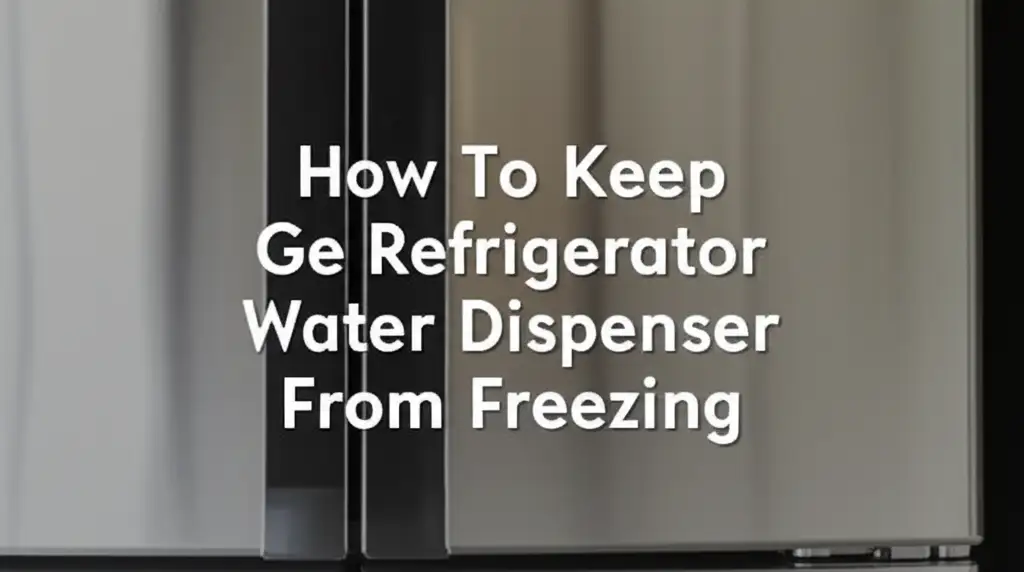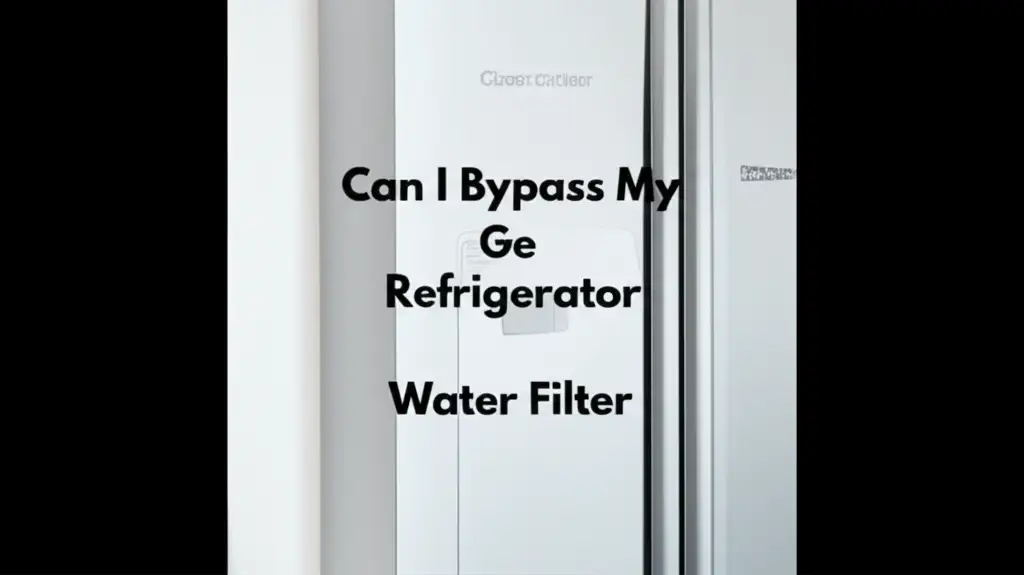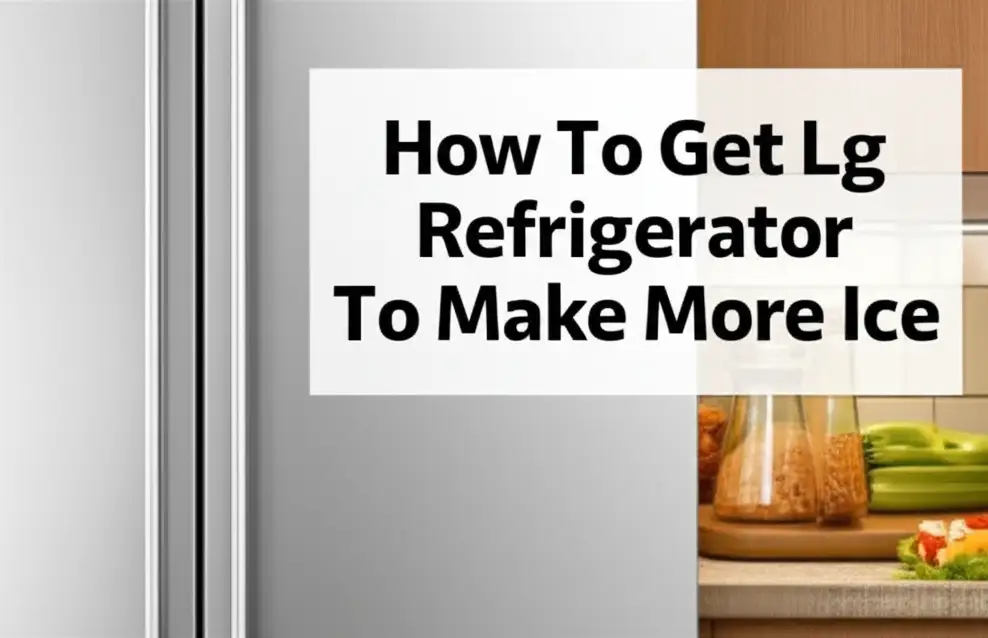· Todd Martin · Refrigerator Maintenance · 16 min read
How To Keep Ge Refrigerator Water Dispenser From Freezing

Keeping Your GE Refrigerator Water Dispenser From Freezing
There is nothing quite like a refreshing glass of cold water from your refrigerator dispenser. What happens when you press the lever and nothing comes out? This can be very frustrating. A frozen water dispenser on your GE refrigerator is a common problem.
Many factors cause this issue. The refrigerator’s internal temperature can be too low. A clogged water filter can restrict flow. The water supply line might have a kink. Finding the cause helps you fix it. This guide shows you how to keep your GE refrigerator water dispenser from freezing. We will explore common culprits and offer simple solutions. You can enjoy perfectly chilled water again.
Takeaway
- Adjust Refrigerator Temperature: Ensure your fridge is not too cold; set it between 37-40°F (3-4°C).
- Replace Water Filter: A clogged filter can restrict water flow, causing freezing; change it every 6 months.
- Inspect Water Line: Check for kinks or bends in the water supply line behind the refrigerator.
- Clear Air Pockets: Air in the line can cause water to freeze; dispense water for a few minutes after filter changes.
- Defrost Frozen Line: Safely thaw a frozen line using a hairdryer or by unplugging the refrigerator.
- Check Inlet Valve: A faulty water inlet valve can lead to insufficient water flow and freezing.
- Monitor Usage: Regular water dispensing helps keep water moving and prevents freezing.
A GE refrigerator water dispenser freezes due to excessively low refrigerator temperatures, a clogged water filter restricting flow, or a kinked/damaged water supply line. Air trapped in the water line or a faulty water inlet valve can also cause freezing. Proper temperature adjustment and regular maintenance are key.
Understanding Why Your GE Water Dispenser Freezes
My GE refrigerator water dispenser sometimes acts up. Many homeowners face the same problem. A frozen water dispenser can be annoying. Understanding why this happens helps fix it. Several common reasons lead to a frozen water line in your GE refrigerator.
The most frequent cause is the temperature inside your refrigerator. If the fridge is too cold, the water line running to the dispenser can freeze. This often happens if the temperature is set below 37°F (3°C). The water line often runs through a colder section of the refrigerator compartment. This makes it vulnerable to freezing.
Another common culprit is a clogged water filter. Your refrigerator water filter cleans the water. Over time, it collects impurities. A clogged filter restricts water flow. When water moves slowly or not at all, it stays in the line longer. This makes it more prone to freezing. This is especially true if the filter is old or not changed regularly.
Sometimes, the water supply line itself causes the issue. A kink or pinch in the line prevents water from flowing freely. This causes water to sit stagnant in the line. Stagnant water freezes more easily. The water line can also have trapped air. Air pockets prevent continuous water flow. Water that stops moving quickly turns to ice.
Finally, a faulty water inlet valve can cause problems. This valve controls water entry into the refrigerator. If it does not open fully or leaks, water flow is inconsistent. Inconsistent flow or small leaks can lead to freezing. Addressing these issues can keep your GE refrigerator water dispenser working.
Checking and Adjusting Refrigerator Temperature Settings
The temperature inside your refrigerator directly impacts the water dispenser. If your GE refrigerator keeps freezing your water dispenser, the internal temperature might be too low. My first step is always to check the temperature settings. This is a simple fix that often solves the problem.
GE refrigerators typically have controls inside. These controls let you adjust the fresh food compartment temperature. The ideal temperature range for a refrigerator is between 37°F (3°C) and 40°F (4°C). Setting the temperature below this range can cause the water line to freeze. The water line usually runs near the back wall or top of the fresh food compartment. These areas are often the coldest.
You can often find the temperature controls on an internal display panel. Sometimes they are simple dials. Adjust the temperature by a degree or two higher. Give the refrigerator some time to stabilize. It can take several hours, or even a full day, for the temperature to fully adjust. Monitor the dispenser afterward.
If your refrigerator has a separate freezer temperature control, check that too. While the water line is in the fridge, overall cooling affects all components. Ensure the freezer is set to 0°F (-18°C) for optimal food preservation. If you notice your fridge freezing food inside, this could also be a sign of too low a temperature setting or a faulty thermistor. You can learn more about general GE refrigerator freezing issues here: Why Does My GE Refrigerator Keep Freezing My Food?.
Always use a reliable thermometer to verify the actual temperature. Refrigerator displays are not always perfectly accurate. Place a thermometer in a glass of water inside the fresh food compartment. Let it sit for a few hours. Then check the reading. This gives you a precise measurement. Adjust the settings again if needed. This step ensures your GE refrigerator water dispenser stays free of ice.
Inspecting and Replacing the Water Filter
A common reason for a GE refrigerator water dispenser to freeze is a clogged water filter. The water filter plays a crucial role in delivering clean water. It removes impurities and sediment from your tap water. Over time, these impurities build up inside the filter. This buildup restricts water flow.
When water flow becomes slow, water sits in the dispenser line longer. This stationary water is much more likely to freeze, especially if your refrigerator is already running cold. I always recommend checking the filter first when I encounter a freezing dispenser. It is a quick and relatively inexpensive fix.
GE recommends replacing your water filter every six months. If you have not replaced your filter recently, this is a good starting point. You might notice a decrease in water pressure from the dispenser. This is another sign of a clogged filter. Replacing the filter often restores proper water flow. This prevents the water from sitting and freezing.
The process of replacing a GE water filter is straightforward. Most GE refrigerators have a filter compartment inside the fresh food section. It might be in the top right corner, on the ceiling, or inside the door. Twist the old filter counter-clockwise to remove it. Insert the new filter and twist it clockwise until it locks into place. Make sure you use a genuine GE replacement filter or a compatible model.
After replacing the filter, you need to bleed the air from the system. Dispense water for about 2-3 minutes. This purges any air trapped in the lines. Air pockets can also cause water to freeze. If your GE refrigerator water dispenser is not working after replacing the filter, air might be the problem. Find more troubleshooting steps for this issue here: Why is my GE Refrigerator Water Dispenser Not Working After Replacing Filter?. You can also find specific instructions for filter replacement for different GE models. For side-by-side models, refer to How to Replace GE Side-by-Side Refrigerator Water Filter. For French door models, see How to Change Water Filter in GE French Door Refrigerator.
Addressing Water Line and Valve Issues
If adjusting the temperature and replacing the filter did not fix your frozen GE refrigerator water dispenser, the problem might be with the water supply line or the inlet valve. These components are vital for delivering water to the dispenser. Any issue here can cause freezing. I always investigate these parts next.
First, check the water supply line behind your refrigerator. This line connects your home’s water supply to the fridge. It is usually a thin plastic or copper tube. Pull the refrigerator away from the wall. Inspect the entire length of the line. Look for any kinks, bends, or pinches. A kink severely restricts water flow. This makes water stagnate and freeze. Gently straighten any kinks you find. Ensure the line has enough slack so it does not bend when the fridge is pushed back.
Next, examine the water inlet valve. This valve is typically located at the bottom rear of the refrigerator. It controls the flow of water into the dispenser and ice maker. Sometimes, sediment or mineral deposits can clog this valve. This prevents it from opening fully. A partially open valve restricts water flow. This can lead to a trickle of water, which freezes quickly.
If the water inlet valve appears faulty, you might need to replace it. A common sign of a faulty valve is a humming sound or no water flow at all. Before inspecting or replacing the valve, turn off the water supply to the refrigerator. Also, unplug the refrigerator from the wall outlet. This ensures safety. If you are not comfortable with this task, consider hiring a professional.
Air trapped in the water line can also cause freezing. When air pockets exist, water does not flow continuously. It sits in sections and freezes. After any maintenance, such as replacing a filter or reconnecting the water line, always flush the system. Dispense water for at least 2-3 minutes. This removes any trapped air. If your GE refrigerator is not dispensing water at all, even after replacing the filter, an air lock or a faulty valve could be the reason. Learn more about such issues here: Why is my GE Refrigerator Not Dispensing Water After Replacing Filter?.
Defrosting a Frozen GE Water Dispenser Line
When your GE refrigerator water dispenser is frozen, you need to thaw the ice blockage. This is a common situation. The good news is that defrosting the line is usually straightforward. I have done this many times. Here are the steps I follow to safely unfreeze the water line.
First, you must access the frozen water line. In most GE refrigerators, the water line runs from the back of the fridge. It goes through the fresh food compartment to the dispenser on the door. The part that freezes is often located where the line enters the door or within the door itself.
The safest way to defrost the line is by unplugging the refrigerator. Turn off the power completely. Then, leave the refrigerator doors open for several hours, or even overnight. This allows the entire compartment, including the water line, to warm up. Place towels on the floor to catch any melted ice. This method is slow but effective. It eliminates the risk of damaging components.
If you need a quicker solution, you can use a hairdryer on a low-heat setting. Direct the warm air specifically at the dispenser area on the door. Focus on the chute and the surrounding plastic. Be careful not to hold the hairdryer too close or for too long in one spot. Overheating can damage plastic components. Keep the hairdryer moving. You can also use a warm, damp cloth. Hold it against the dispenser area. The heat will slowly melt the ice inside.
Once the ice melts, you should hear water running. Plug the refrigerator back in. Turn the water supply back on. Then, immediately dispense several gallons of water. This flushes out any remaining air or debris. It also helps to keep the water moving. Moving water is less likely to freeze again.
After defrosting, reconsider why the line froze. Was the temperature too low? Is the filter old? Addressing the root cause prevents future freezing. Regular use of the dispenser also helps keep the water flowing. This reduces the chances of it freezing again.
Advanced Troubleshooting: Thermistor and Control Board
Sometimes, the simple fixes for a frozen GE refrigerator water dispenser are not enough. If you have checked the temperature, replaced the filter, and inspected the water lines, the issue might lie with internal electronic components. These components include the thermistor and the control board. These require more advanced troubleshooting. I only approach these if other methods fail.
The thermistor is a temperature sensor. It sends temperature readings to the refrigerator’s control board. The control board uses these readings to regulate cooling cycles. If the thermistor is faulty, it might send incorrect temperature data. For example, it could tell the control board the fridge is warmer than it actually is. This causes the control board to make the compressor run longer. The refrigerator then gets too cold. An overly cold fresh food compartment leads to the water line freezing.
You can test a thermistor’s resistance using a multimeter. The resistance should change with temperature. If the readings are out of specification or do not change, the thermistor is likely faulty. This is a more technical repair. Replacing a thermistor usually involves locating it within the refrigerator. It is often clipped to the evaporator coils or inside the fresh food compartment.
The main control board is the brain of your GE refrigerator. It processes signals from various sensors, including the thermistor. It controls the compressor, fans, and dispenser functions. A faulty control board can cause erratic temperature control. It might incorrectly cycle the compressor or fail to regulate cooling. This could lead to sections of the fridge becoming too cold. This can then freeze the water dispenser line.
Diagnosing a faulty control board is difficult for a homeowner. There are usually no clear visual signs. Testing requires advanced knowledge and specialized tools. Symptoms like inconsistent temperatures, unexpected cycles, or complete lack of cooling point to a control board issue. If you suspect either the thermistor or the control board is the problem, I recommend calling a qualified appliance technician. These are complex parts. Improper handling can cause further damage to your GE refrigerator. They have the expertise and tools to diagnose and replace these components safely.
Regular Maintenance Tips to Prevent Freezing
My experience shows that regular maintenance is key to preventing a GE refrigerator water dispenser from freezing. Following a consistent maintenance schedule helps avoid many common appliance problems. Proactive care saves you time and money on repairs. I always advise homeowners to adopt these habits.
First, regularly check your refrigerator’s temperature settings. Even if you set it correctly once, accidental bumps or power surges can sometimes alter them. Use a refrigerator thermometer to confirm the temperature is within the ideal range of 37-40°F (3-4°C). Check this every few months. Keeping the temperature stable prevents the water line from getting too cold and freezing.
Second, make a habit of replacing your water filter every six months. This is crucial. A new filter ensures optimal water flow. This prevents water from sitting stagnant in the lines. Stagnant water is much more susceptible to freezing. Mark your calendar for filter changes. It is a simple task that prevents a lot of headaches.
Third, periodically inspect the water supply line behind your GE refrigerator. Do this when you clean behind the fridge. Look for any kinks, pinches, or signs of wear. Ensure the line is not pressed against the wall. A small adjustment can prevent a future freeze-up. This check ensures unimpeded water flow to the dispenser.
Fourth, clean the condenser coils at least once or twice a year. The condenser coils are located at the bottom or back of the refrigerator. They dissipate heat. When coils are dirty, the refrigerator works harder to cool. This can affect overall temperature regulation. It can lead to colder-than-needed temperatures in some areas. Use a vacuum cleaner with a brush attachment to remove dust and debris.
Finally, use your water dispenser regularly. Consistent use keeps water moving through the lines. Moving water is less likely to freeze. If you go on vacation, consider shutting off the water supply to the refrigerator. Drain the dispenser line before you leave. This prevents water from sitting idle and freezing while you are away. Implementing these maintenance steps extends the life of your GE refrigerator and keeps your water dispenser working perfectly.
FAQ Section
Q1: Why does my GE water dispenser keep freezing? A: Your GE water dispenser likely freezes due to the refrigerator’s temperature being set too low, often below 37°F (3°C). Other causes include a clogged water filter restricting flow, a kinked water supply line, or air trapped within the water line. A faulty water inlet valve can also lead to freezing issues by impeding proper water delivery.
Q2: Can a bad water filter cause the dispenser to freeze? A: Yes, a clogged or old water filter can definitely cause your GE water dispenser to freeze. A filter full of sediment restricts water flow significantly. When water moves slowly or becomes stagnant in the line, it is more prone to freezing. Replacing the filter every six months helps maintain proper flow.
Q3: How do I defrost a frozen water line in my GE fridge? A: To defrost a frozen water line, first unplug your GE refrigerator. You can leave the refrigerator doors open for several hours, or overnight, to allow the ice to melt naturally. For a quicker fix, carefully use a hairdryer on a low setting, directing warm air at the dispenser area, or apply warm, damp cloths to the frozen section.
Q4: What temperature should my GE refrigerator be set to to prevent freezing? A: To prevent your GE refrigerator water dispenser from freezing, set the fresh food compartment temperature between 37°F (3°C) and 40°F (4°C). This range is optimal for food preservation and helps ensure the water line, often running through a colder section, does not get cold enough to freeze.
Q5: When should I call a technician for a freezing GE dispenser? A: Call a technician if basic troubleshooting steps like adjusting temperature, replacing the filter, and checking water lines do not resolve the freezing issue. This is especially true if you suspect problems with internal components like the thermistor or the main control board. These parts require specialized diagnosis and repair.
Q6: Does air in the water line cause freezing? A: Yes, air trapped in the water line can cause the water dispenser to freeze. Air pockets disrupt the continuous flow of water. This means water can sit stagnant in sections of the line. Stagnant water, especially in colder parts of the refrigerator, is more susceptible to freezing than consistently flowing water.
Conclusion
Keeping your GE refrigerator water dispenser from freezing does not have to be a mystery. By understanding the common causes and following specific troubleshooting steps, you can maintain a steady flow of cool water. I have found that checking the temperature settings, regularly replacing the water filter, and inspecting the water lines are the most effective first steps. These simple checks prevent many issues.
Addressing a frozen water line quickly helps avoid further damage to your appliance. Remember to prioritize safety by unplugging the refrigerator before any hands-on work. If you encounter more complex issues involving the thermistor or control board, do not hesitate to seek professional help. Your GE refrigerator is a valuable appliance.
Regular maintenance is key to a perfectly functioning GE refrigerator water dispenser. A little proactive care goes a long way. Make these maintenance tips part of your routine. You can enjoy perfectly chilled water without any unexpected freezing. Start implementing these steps today for a reliable and functional water dispenser.
{ “publishDate”: “2025-07-06T00:00:00Z”, “title”: “How To Keep Ge Refrigerator Water Dispenser From Freezing”, “excerpt”: “Stop your GE refrigerator water dispenser from freezing. Learn effective troubleshooting, temperature adjustments, and maintenance tips to prevent ice blockages.”, “image”: “https://res.cloudinary.com/dbcpfy04c/image/upload/v1751680926/blog_image_1751680926_oluoel.webp”, “category”: “Refrigerator Maintenance”, “tags”: [ “GE refrigerator freezing”, “water dispenser issues”, “frozen water line”, “appliance troubleshooting”, “refrigerator repair” ], “metadata”: { “canonical”: “https://www.homeessentialsguide.com/how-to-keep-ge-refrigerator-water-dispenser-from-freezing” } }
- GE refrigerator freezing
- water dispenser issues
- frozen water line
- appliance troubleshooting
- refrigerator repair





